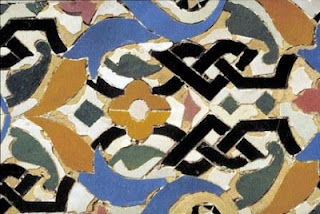This will give you a great overview of the process though from sealing the cement board to wiping the tile clean.
Now for a bit of the explanations behind the process.
Avente's Spanish Tiles are beautifully hand-painted in a variety of colors and patterns on ceramic bisque using time-honored techniques.
Using the Majolica technique of glazing, our Hand-Painted Spanish Ceramic Tile designs include colorful patterns from the different regions of Spain, or the traditional blue and white found in the New Iberica border tiles and liners.The Majolica technique utilizes an opaque white tin-based glaze that is ideal for vibrant, colorful patterns and designs for ceramics. The centuries-old technique is believed to have originated in 9th century Mesopotamia with the desire to imitate the white porcelain wares coming from China. Over time, and with the spread of Islam, the art made its way through to Northern Africa, and to what is now known as Spain, Italy, The Netherlands and the United Kingdom.
Within our hand-painted Spanish ceramic tile collection, you'.ll find craftsmanship and fine examples of the traditional Majolica ceramic method, such as those used for this Spanish stair riser project:
Andalucia | Cadiz | Albacete |
Burgos | Caceres |
Our hand-painted Spanish ceramic tile designs include borders, corners, large decorative tiles, and accent dots. Use the 3"x6" tiles to create a border, or make a bold design statement using the 2" dots in a row. The 1" dots, used as an accent to a floor inset, are a fitting complement to a backsplash consisting of 6"x6" tiles of the same design. These versatile collections, with their stunning colors, create a timeless look that blend well with hand-painted Spanish Field Ceramic Tile, which were created specifically to complement the subtle color schemes found in our Hand-Painted Spanish Ceramic Tile line. Use these tiles for kitchens, bathrooms, warm weather pools and fountains. For more inspiration, check out Spanish Style Stair Risers, Spanish Tiles on an Entry Path, and Spanish Tile on Stair Risers.
Considering Spanish ceramic tile for your next project? Then let us help you find some inspiration. Visit our Ceramic Tile Design Ideas section.
Where would you use hand-painted Spanish ceramic tiles? What pattern would you choose?
 |
| A central 10-point star is the beginning point of this expanding zillij pattern Image Source: Ceramics Today via Saudi Aramco World. Photo Credits: Peter Sanders/Saudi Aramco World/PADIA. |
 |
| The 17th-century Nejjarine Fountain, retiled and repaired by two generations of master zlayjis of the Benslimane family. Image Source: Ceramics Today via Saudi Aramco World. Photo Credits: Peter Sanders/Saudi Aramco World/PADIA. |
 |
| Zillij patterns, including a taqshir calligraphic border, at the Attarine madrasa (Islamic school), built in 1325. Image Source: Ceramics Today via Saudi Aramco World. Photo Credits: Peter Sanders/Saudi Aramco World/PADIA. |
 |
| Zillij, or tilework of Morocco.Image Source: Ceramics Today via Saudi Aramco World. Photo Credits: Peter Sanders/Saudi Aramco World/PADIA. |
 |
| Handmade cement tile inspired by Moroccan patterns. "Fez" by Avente Tile. |